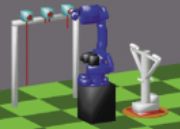E-Archive
Articles
in Vol. 2 - November Issue - Year 2001
A Concept Study and its Realization using Computer Simulations

Top View of Simulation

Side View of Simulation

Robot getting new Tool

Robot exercising Internal Peening


Baiker AG, Switzerland is a manufacturer of Dry & Wet Peening and Blasting Equipment. It mainly works with the Aviation and Automotive Industry. It was founded in 1935.
If geometrically complicated parts have to be peened, a nozzle has to be moved in various axis and planes. It is not always easy for the engineers to imagine all these three-dimensional movements. Simulations are an efficient tool to avoid mistakes in a machine's layout.
Liebherr Aerospace Lindenberg GmbH in Germany, the robot manufacturer MOTOMAN and Baiker AG, the Swiss manufacturer of high end peening machines, decided to explore new ways in doing a concept study for an application to peen landing gears.
Strict Requirements for the Degree of Automation
The customer demanded that a landing gear has to be peened completely in one set up without any program interruptions. However, the peening of such landing gears involves the availability of 3 different nozzle types. The outer surface of the landing gear has to be treated by a set of two external peening nozzles. The two smaller horizontal holes will receive their surface finishing using a rotation head with revolving lance. Finally a very long vertical hole has to be internally peened by means of a 1.4 meter long lance while the landing gear itself is rotating. So the robot was supposed the grasp all those tools by itself since no manual operation was allowed. The designing of a tool station mounted onto the cabin wall was one thing, but to insure that the robot would manage all the movements along the work piece and to the tool station was another matter completely.
Computer Simulation
In a joint effort of the customer, MOTOMAN and the Swiss equipment manufacturer, it was possible to demonstrate the whole process as computer simulation. In this computer video one could observe all tool, landing gear and robot movements. It was also possible to make a fairly good estimate concerning the peening time for each work piece. In the end all parties involved did benefit. The customer felt more comfortable making a decision having seen a simulation of the process ahead of time, while the equipment manufacturer was certain to avoid wrong assumption during the engineering.
Equipment
The equipment finally delivered to Liebherr Aerospace Lindenberg GmbH was a glass bead peening machine using a total of 3 pieces of closed loop media flow rate control units. Being able to measure the media flow rate also for non magnetic media such as glass beads, it was possible to record all peening parameters and to display them on a computer screen. The whole machine was lowered into a ditch, so the cabin floor was on the same level as the workshop floor. It is probably one of few machines world-wide, in which such complicated parts can be peened truly in one set up.
"Developing a process which has never been done in a similar fashion before, can always bring surprises. As far as shot peening equipment concerns, we had for the first time the opportunity to see the feasibility of a particular application before the machines were in place."
Alexander Amann
Process Engineer of Liebherr Aerospace Lindenberg GmbH, Germany
For information: BAIKER AG
Dry & Wet Peening Technology
Alipenstr. 1, 8152 Glattbrugg
Switzerland
Tel: +41.1.810 73 77
Fax: +41.1.810 93 40
e-mail: info@baiker.ch
Internet: www.baiker.ch



























